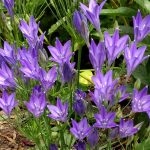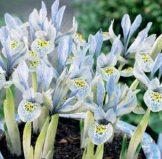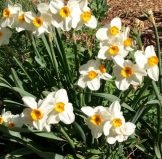
We still have LOTS of gorgeous spring-flowering bulbs! When these ‘buried treasures’ emerge, they are among the first signs of spring and are welcomed not only for their beauty, but also for providing early pollen and nectar sources for our pollinating insect as they, too, emerge.
Customers have been inquiring about which bulbs can thrive in the particular circumstances of their gardens. Whether you have a rock garden, native garden, xeriscape, fragrance garden, traditional flower border, cutting garden, or meadow, or you are living with deer, squirrels, chipmunks, limited water, baking sun, shade, clay soil or decomposed granite, there are spring flowering bulbs you can grow successfully, and we still have plenty of them! We carefully curate our selection to provide the best of the best for our climate and all our various garden types.
For the Native garden: Most of the spring-flowering bulbs that are available in commerce originate from species that grow in Central Asia, Persia, and the Mediterranean region.
A few are native to the western US:

Allium ‘Graceful Beauty’
Allium amplectens ‘Graceful Beauty’: This hardy (Zone 4) beauty sports 3–inch spherical heads packed with starry white flowers accented by lavender anthers atop 12-16” stems. The species is common in clay soils in hot dry openings west of the Sierra Nevada in California and spots in Oregon, and Washington, and southwest B.C.
Camassia quamash ‘Blue Melody’:
This Pacific Northwest native is best grown in moist, fertile, well-drained soil in morning sun or filtered sun. Generally ignored by deer and rodents, Blue Melody forms substantial clusters of linear strappy foliage with very showy yellow margins around upright racemes studded with dozens of 2″, star-shaped dark blue flowers with yellow anthers and green centers that open from the bottom to the top in May and June. Bulb size: 6 cm/up. HZ: 4-8. Height: 15″. Large colonies of camas were abundant in the region and indigenous peoples depended on the starchy bulbs for food.

Tritelia ‘Queen Fabiola’
Triteleia laxa ‘Queen Fabiola’ and T. laxa ‘Rudy’:
T. laxa is a stunning, easy-to-grow California native wildflower that will naturalize and return every year. Listed as hardy to Zone 6, it has been solidly perennial for many years in our Longmont garden, where it blooms for weeks in May and June. ‘Queen Fabiola’ has large umbels of violet blue starry trumpet flowers atop slender 20-15” stems, while ‘Rudy’’s flowers are light blue with striking deep purple stripes. Both are drought tolerant but flower better with more consistent watering. They are also known for their long vase-life, up to two weeks!
Does you garden abound in wildlife, such as deer, rabbits, squirrels, or chipmunks that are not fenced out? These are your best bets:

Nectaroscordum (Allium)
All Narcissus/Daffodils: Lucky for us, Narcissus (Daffodils) contain toxins that critters can detect by small and will leave them alone.
Alliums: These ‘ornamental onions’ are shunned by most critters most of the time. They are not toxic (except to cats), but their odor usually deters critters.
Hyacinths: These are toxic to critters and even some humans have skin sensitivities to the bulbs and should wear gloves when handling them.
Camas: Reportedly ignored by deer.
Iris: Reportedly ignored by deer and rabbits.
Do you have a rock garden or naturalistic garden?

Tulipa ‘The First’
Here are some choice, jewel-like small species bulbs that are easy to tuck into a well-drained sunny rockery, at the base of shrubs and trees, or at the front of a traditional border. They generally prefer moisture in late winter and early spring, and can go dry once their foliage has died back. They are the earliest to bloom, sometimes starting as early as January in some years, and will make spreading clumps that increase in size, bloom period and impact over the years. Their value to pollinators is enormous.
Anemone blanda ‘Blue Shades’ – bloom April/May
Corydalis solida ‘Beth Evans’(pink) – prefers dappled shade or morning sun, early spring
Crocus species – bloom February/March
Galanthus nivalis/Snowdrops – blooms as early as February!
Crocus vernus selections (Dutch or Giant crocus) – bloom March/April
Iris reticulata selections – bloom early March – mid April
Iris histrioides selections – bloom late February – March
Iris bucharica (Juno Iris)
Tulip species such as T. batalinii ‘Bronze Charm’, T. bakeri ‘Lilac Wonder’, T. humilis coeruliea occulata (very early), T. ‘Little Princess’, T. kaufmanniana ‘The First’ (very early & longblooming), T. griegii ‘Red Riding Hood (purple-streaked foliage!), T. ‘Norah’
Miniature Narcissus such as ‘Twinkling Yellow’, ‘Golden Bells’, ‘Jetfire’, ‘Tete a Tete’, ‘Snipe’, ‘Golden Echo’, ‘Xit’, ‘Pipit’ Miniature Blend, ‘Tiny Bubbles’, ‘Oxford Gold,’ ‘Lobularis’

Iris histrioides ‘Katharine Hodgkin’
Some great selections for the Xeriscape garden:
Allium ‘Mountain Mix’
Allium albopilosum (Christophii) Star of Persia
Allium rosenbachianum
Allium ‘Gladiator’
Allium ‘Red Giant
Allium ‘Cameleon’
Allium caeruleum (azureum)
Chionodoxa forbesii (Blue Glory-of-the-Snow)
Colchicum speciosum (stunning in the fall garden; plant now for blooms next September)
Chionodoxa lucillae (White Glory-of-the-Snow)
Triteleia ‘ Queen Fabiola’
Trieleia ‘Rudy’
Crocus chrysanthus ‘Gipsy Girl’,
Crocus tommassinianus ‘Firefly’, ‘Tricolor’
Eremurus stenophyllus (syn. Bungeii)
Iris histrioides selections
Iris reticulata selections
Tulipa species
Muscari selections

Narcissus ‘Geranium’
These Bulbs will enhance your Fragrance Garden:
Narcissus poeticus
Narcissus ‘Odoratus Plenus’
Tulip (Triumph) ‘Princess Irene’
Tulip ‘(fosteriana) ‘Red Queen’
Tulip (Triumph) ‘Pretty Princess’
Narcissus jonquilla ‘Pipit’
Narcissus ‘Xit’
Narcissus tazzeta ‘Thalia’
Narcissus tazzeta ‘Geranium’
Iris reticulata selections
Hyacinth varieties
Showstoppers & Cut Flowers:
Allium nectaroscordum
Tulips: ‘Spryng Break’, ‘Artist’, ‘Red Riding Hood’, ‘Blueberry Ripple’, ‘Daydream’, ‘Red

Eremurus stenophyllus syn. bungei
Madonna’, ‘Orange Emperor’, ‘Red Emperor’, ‘Norah’, ‘Coerulea Oculata’, ‘Blushing Impression’
Triteleia ‘Queen Fabiola’ and ‘Rudy’
Eremurus stenophyllus (syn. bungei)
Camassia ‘Blue Melody’
Narcissus: ‘Cornish King’, ‘Ice King’, ‘Ice Follies’, ‘Carlton’, ‘Geranium’, ‘Mount Hood’, ‘Altruist’

Chionodoxa forbesii
These will thrive in the Shady or Partly Shaded Garden:
Galanthus nivalis/Snowdrops
Ipheion uniflorum ‘Jessie’ – Sorry, sold out for 2023
Corydalis solida ‘Beth Evans’
Lilium martagon ’Claude Shride’
Muscari species – Sorry- sold out for 2023
Anemone blanda ‘Blue Shades’
Chionodoxa forbesii (Blue Glory-of-the-Snow)
Chionodoxa lucillae (White Glory-of-the-Snow)
Colchicum speciosum (fall-blooming)
Crocus speciosus (fall-blooming) Sorry – sold out for 2023
Narcissus ‘Lobularis’
